Appendiceal Intussusceptions in a 5-Year-Old Boy
Article Information
Salih Grajçevci1, Hysni Jashari1, Murat Berisha1, Guri Hyseni1, Masum Rahman2, Ina Kola3, Ali Guy4, Fjolla Hyseni5 *, Anisa Cobo6, Juna Musa7
1Department of Pediatric Surgery Clinic, University Clinical Centre of Kosova, Prishtina, Kosovo
2Department of Neurologic Surgery, Mayo Clinic, Rochester, MN, USA
3Plastic Surgery Resident, Department of “Burns and Plastic Surgery”, University Hospital Center “Mother Theresa”, Tirana, Albania
4Clinical Assistant Professor, Department of Physical Medicine and Rehabilitation, New York University School of Medicine, NYU Medical Center, New York, USA
5Department of Urology, NYU Langone Health, New York, USA
6University of Medicine, Tirana, Albania
7Department of Surgery Physiology and Biomedical Engineering Mayo Clinic, Rochester, Minnesota, USA
*Corresponding Author: Fjolla Hyseni Vokshi, Department of Urology, NYU Langone Health, New York, USA
Received: 25 January 2021; Accepted: 06 February 2021; Published: 30 March 2021
Citation:
Salih Grajçevci, Hysni Jashari, Murat Berisha, Guri Hyseni, Masum Rahman, Ina Kola, Ali Guy, Fjolla Hyseni, Anisa Cobo, Juna Musa. Appendiceal Intussusceptions in a 5-Year-Old Boy. Journal of Surgery and Research 4 (2021): 167-171.
View / Download Pdf Share at FacebookAbstract
Appendiceal intussusception (AI) is a rare condition with an incidence of approximately 0.01%. It is usually intraoperatively diagnosed in patients with suspected acute appendicitis and characterized by an invagination of the appendix into the cecum to various degrees. The treatment is surgical reduction of the appendix and appendectomy; however since symptoms are not specific, clinical diagnosis is challenging and frequently only made during surgery. We present the case of a 5- year-old boy who presented with a three day history of right lower quadrant pain. Abdominal ultrasound of this region showed a tubular structure of an 8mm in diameter. During laparotomy, an intussuscepted appendix with 1/3 of its base invaginated into the cecum was confirmed.
Keywords
Appendix; Laparatomy; Surgery; Appendectomy
Appendix articles; Laparatomy articles; Surgery articles; Appendectomy articles
Appendix articles Appendix Research articles Appendix review articles Appendix PubMed articles Appendix PubMed Central articles Appendix 2023 articles Appendix 2024 articles Appendix Scopus articles Appendix impact factor journals Appendix Scopus journals Appendix PubMed journals Appendix medical journals Appendix free journals Appendix best journals Appendix top journals Appendix free medical journals Appendix famous journals Appendix Google Scholar indexed journals Laparatomy articles Laparatomy Research articles Laparatomy review articles Laparatomy PubMed articles Laparatomy PubMed Central articles Laparatomy 2023 articles Laparatomy 2024 articles Laparatomy Scopus articles Laparatomy impact factor journals Laparatomy Scopus journals Laparatomy PubMed journals Laparatomy medical journals Laparatomy free journals Laparatomy best journals Laparatomy top journals Laparatomy free medical journals Laparatomy famous journals Laparatomy Google Scholar indexed journals Surgery articles Surgery Research articles Surgery review articles Surgery PubMed articles Surgery PubMed Central articles Surgery 2023 articles Surgery 2024 articles Surgery Scopus articles Surgery impact factor journals Surgery Scopus journals Surgery PubMed journals Surgery medical journals Surgery free journals Surgery best journals Surgery top journals Surgery free medical journals Surgery famous journals Surgery Google Scholar indexed journals Appendectomy articles Appendectomy Research articles Appendectomy review articles Appendectomy PubMed articles Appendectomy PubMed Central articles Appendectomy 2023 articles Appendectomy 2024 articles Appendectomy Scopus articles Appendectomy impact factor journals Appendectomy Scopus journals Appendectomy PubMed journals Appendectomy medical journals Appendectomy free journals Appendectomy best journals Appendectomy top journals Appendectomy free medical journals Appendectomy famous journals Appendectomy Google Scholar indexed journals Appendiceal intussusception articles Appendiceal intussusception Research articles Appendiceal intussusception review articles Appendiceal intussusception PubMed articles Appendiceal intussusception PubMed Central articles Appendiceal intussusception 2023 articles Appendiceal intussusception 2024 articles Appendiceal intussusception Scopus articles Appendiceal intussusception impact factor journals Appendiceal intussusception Scopus journals Appendiceal intussusception PubMed journals Appendiceal intussusception medical journals Appendiceal intussusception free journals Appendiceal intussusception best journals Appendiceal intussusception top journals Appendiceal intussusception free medical journals Appendiceal intussusception famous journals Appendiceal intussusception Google Scholar indexed journals cystic fibrosis articles cystic fibrosis Research articles cystic fibrosis review articles cystic fibrosis PubMed articles cystic fibrosis PubMed Central articles cystic fibrosis 2023 articles cystic fibrosis 2024 articles cystic fibrosis Scopus articles cystic fibrosis impact factor journals cystic fibrosis Scopus journals cystic fibrosis PubMed journals cystic fibrosis medical journals cystic fibrosis free journals cystic fibrosis best journals cystic fibrosis top journals cystic fibrosis free medical journals cystic fibrosis famous journals cystic fibrosis Google Scholar indexed journals intestinal intussusceptions articles intestinal intussusceptions Research articles intestinal intussusceptions review articles intestinal intussusceptions PubMed articles intestinal intussusceptions PubMed Central articles intestinal intussusceptions 2023 articles intestinal intussusceptions 2024 articles intestinal intussusceptions Scopus articles intestinal intussusceptions impact factor journals intestinal intussusceptions Scopus journals intestinal intussusceptions PubMed journals intestinal intussusceptions medical journals intestinal intussusceptions free journals intestinal intussusceptions best journals intestinal intussusceptions top journals intestinal intussusceptions free medical journals intestinal intussusceptions famous journals intestinal intussusceptions Google Scholar indexed journals
Article Details
1. Introduction
Appendiceal intussusception is a rare condition with an incidence of approximately 0.01% of patients who underwent appendectomy [1].This condition can mimic various chronic and acute abdominal conditions. It is an important entity to recognize since it could be mistaken for a cecal mass [2]. The pediatric age group is most often affected. Appendiceal intussusception can occur without any underlying abnormality [3]. Anatomical variations of the appendix and pathological conditions such as tumors or polyps,endometriosis, parasitism,cystic fibrosis,fecalithsand foreign bodies, lymphoid follicles have all been described as possible causes. Symptoms of appendiceal intussusception have been divided into four groups:asymptomatic patients, symptoms similar to acute appendicitis, symptoms consistent with intestinal intussusceptions, and a prolonged history of intermittent severe attacks of right lower quadrant abdominal pain [4].Vomiting and melena may be present. The diagnosis is rarely made preoperatively because of its variable presentation and nonspecific symptoms. We report on a 5-year-old boy with this condition and discuss features that may direct the pediatric surgeon to achieve early recognition and provide optimal treatment.
2. Case Representation
A 5-year-old boy presented with a 3-day history of right lower quadrant pain, no vomiting, and high body temperature. The labs were remarkable for a WBC of 8.9 with 46% lymphocytes and 36% granulocytes. Ultrasound of the abdomen showed enlarged lymph nodes in the right lower quadrant with a diameter up to 14mm.
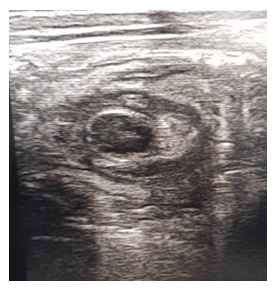
Figure 1: Ultrasound of the abdomen.
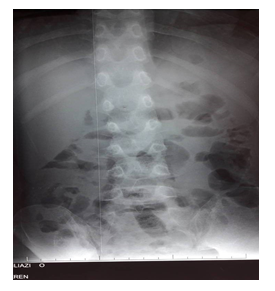
Figure 2: X ray – abdomen.
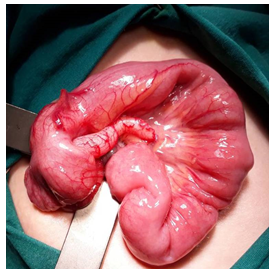
Figure 3: The base of the appendix

Figure 3: The base of the appendix
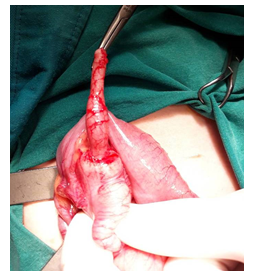
Figure 4: Front view of the invaginated
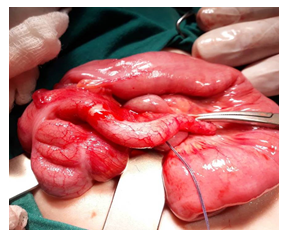
Figure 5: Appendix after retraction.
A tubular formation was also described in this region with an 8mm in diameter suspicious for appendiceal intussusceptions (Figure 1). Native X-ray of the abdomen showed a few “small” air-fluid levels in the right lower part of the abdomen (Figure 2). The boy was taken for laparotomy. During surgery we found an intussuscepted appendix with 1/3 of its base invaginated into the cecum (Figures 3-5). Biopsy confirmed dense inflammatory polimorphonuclear, with an intense vascular hyperemia.
3. Discussion
The most common causes of appendiceal intussusception in children include Appendiceal inflammation secondary to fecalith, foreign body, hypertrophic lymphoid follicle, parasite, lipoma, and hamartomatous polyp [2]. Other causes seen exclusively in the adult population include mucocele, adenocarcinoma, carcinoid, endometriosis, and metastases [5]. Appendiceal intussusception is particularly rare with an incidence of 0.01% according to a pathologic review of 71,000 human appendix specimens [1].
Different clinical presentations have been described for appendiceal intussusceptions [1].The mainstay of clinical presentation is intermittent abdominal pain while patients may be completely asymptomatic between attacks. Appendiceal intussusception may act as a leading point to ileocolic intussusception, and is frequently concealed by it [3]. Pre-operative diagnosis of intussusception of the appendix is now possible due to the advancement in radiological and endoscopic imaging. In fact, the majority of cases reported after the year 2000 were diagnosed with AI before surgery [3, 4]. Ultrasound has an important role, especially in children [3, 6]. When these entities present concurrently, as in our case, it brings up a “chicken or the egg” type of question, whether the inflamed appendix was the lead point of the intussusception or whether the intussusception caused strangulation and inflammation of the appendix [7]. Beyond the rarity of this diagnosis, this was a challenging case for a variety of reasons. No labs were obtained to evaluate for leukocytosis which might have prompted further discussion of the differential diagnosis [7].Less commonly, appendiceal intussusceptions may also be asymptomatic with incidental diagnosis by variable imaging studies [8]. Longitudinal sonograms may show the inverted appendix protruding into the caecal lumen [6, 9]. Intussusception of the appendix is classified into five anatomic types [10]: type I - invagination of the appendiceal tip; type II - the appendiceal tip is more invaginated to the proximal part of the appendix; type III - intussusception begins at the appendiceal base; type IV - retrograde intussusception; type V - complete appendiceal invagination into the cecum [10]. In our case it was the type III.
The treatment of appendiceal intussusception can be conservative, minimally invasive, and surgical [11, 12]. The intussuscepted appendix may be reduced with a barium enema or air enema. Appendectomy is the treatment of choice in both children and adults [12]. It can be carried out by means of a laparotomy or laparoscopically [11, 12]. Both pediatric surgeons and radiologists should be aware of this occurrence to provide adequate management and avoid complications.
4. Conclusion
Appendiceal intussusception should be considered in the differential diagnosis in children with abdominal pain. Both pediatric surgeons and radiologists should be aware of this rare entity as it was presented in our case with type III - intussusception beginning at the appendiceal base and should provide adequate management and avoid complications.
References
- Collins DC. 71,000 human appendix specimens. A final report, summarizing forty years study.Am J Protocol 14(1963): 265-281.
- J Pohl. Intussusception of the Appendix, Dr.-Horst-Schmidt-Klinik, Wiesbaden, Germany 12 (20120: 377-379.
- Samuk I, Nica A, Lakovski Y, et al. Appendiceal intussusceptions: A diagnostic Challenge, Eur J Pediatr Surg 28(2018): 30-33.
- Jonah Luzier, Peter Verhev, Nora Dobos. Preoperative CT diagnosis of Appendiceal intussusceptions,American Journal of Roentgenology 187 (2006): 325-326.
- Ijaz S, Lidder S, Mohamid W, et al. Intussusception of the appendix secondary to endometriosis: a case report. Journal of Medical Case Reports 2 (2008): 12.
- Koumanidou C, Vakaki M, Theofanopoulou M, et al. Appendiceal and appendiceal-ileocolic intussusception: sonographic and radiographic evaluation.PediatrRadiol 31(2001): 180-183.
- Marjon L1,Hull N1,Thomas K. Concurrent acute appendicitis and ileocolic intussusception in a 1-year-old child, Radiol Case Rep 13 (2018): 655-657.
- Offodile A, Hodgin JB, Arnell T. Asymptomatic intussusceptions of the appendix secondary to endometriosis, Am Surg 73 (2007): 299-301.
- Atkinson GO, Gay BB, Naffis D Jr. Intussusception of the appendix in children, 1American Journal of Roentgenology 126(1976): 1164-1168.
- Mcswain B. Intussusception of the appendix. Review of the literature and report a case.Soth Med J 34 (1941): 263-271.
- Iqbal CW, Kamath AS, Zietlow SP. Appendiceal intussusception masquerading as an ileocolic intussusception.J Gastrointest Surg 16(2012): 1076-1077.
- Alaee A. Reducible appendiceal intussusception: a case report and review the literatures.J Pediatr Rev 1(2013): 70-76.
